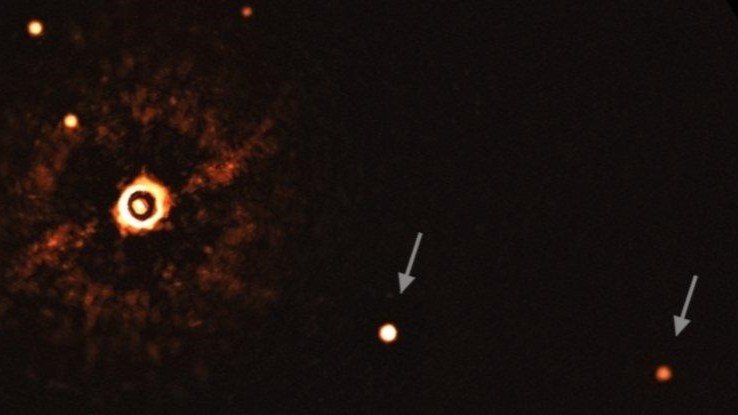The First Direct Image of a Multi-Planet System Around a Sun-Like Star
In a groundbreaking achievement for astronomy, an international team of scientists has successfully captured the first-ever direct image of a multi-planet system orbiting a star akin to our Sun. This remarkable discovery, made using the European Southern Observatory’s (ESO) Very Large Telescope (VLT), provides unprecedented insights into the formation and evolution of planetary systems, potentially shedding light on the early history of our own solar system.
The Discovery: TYC 8998-760-1
The star at the center of this discovery is named TYC 8998-760-1, located approximately 300 light-years away in the constellation Musca. At just 17 million years old, TYC 8998-760-1 is significantly younger than our Sun, which is over 4.5 billion years old. This youthfulness is crucial, as it allows astronomers to observe planets that are still hot and luminous from their formation processes. The image reveals two giant exoplanets, designated TYC 8998-760-1b and TYC 8998-760-1c, which are seen as bright points of light in the captured photograph. These planets orbit their host star at distances of 160 and 320 times that of the Earth-Sun distance, respectively, placing them much farther from their star than Jupiter and Saturn are from our Sun.
Imaging Technique: SPHERE Instrument
To achieve this remarkable feat, researchers employed the SPHERE (Spectro-Polarimetric High-contrast Exoplanet REsearch) instrument on the VLT. SPHERE utilizes a technique called coronagraphy, which blocks out the overwhelming light from the star, allowing fainter objects—like distant planets—to be detected. This method is particularly effective for observing young planets that are still emitting heat and light due to their recent formation.
Characteristics of the Exoplanets
The two newly imaged exoplanets are notably massive:
- TYC 8998-760-1b: Approximately 14 times the mass of Jupiter.
- TYC 8998-760-1c: About 6 times the mass of Jupiter.
Interestingly, TYC 8998-760-1b may even classify as a brown dwarf, a type of celestial object that lies between planets and stars in terms of mass and characteristics.
Implications for Planetary Science
This discovery is not merely an impressive technological achievement; it has profound implications for our understanding of planetary systems. According to lead researcher Alexander Bohn from Leiden University, this observation provides a “snapshot” of an environment that closely resembles our solar system but at an earlier evolutionary stage. Such insights could help astronomers unravel how planets form and evolve around stars similar to our Sun. Matthew Kenworthy, co-author and associate professor at Leiden University, emphasized the significance of direct imaging in searching for environments that could support life. Despite thousands of exoplanets being detected indirectly through various methods, only a small fraction have been directly imaged. This makes the imaging of multi-planet systems particularly rare—prior to this discovery, only two other systems had been observed with multiple planets around stars vastly different from our Sun.
Future Prospects
Looking ahead, astronomers are excited about the potential for future discoveries with next-generation telescopes like the Extremely Large Telescope (ELT). These advanced instruments are expected to detect even lower-mass planets around TYC 8998-760-1, further enhancing our understanding of multi-planet systems and their evolution.
Conclusion
The first direct image of a multi-planet system around a Sun-like star marks a significant milestone in astronomical research. It opens new avenues for exploring planetary formation and evolution while providing valuable context for understanding our own solar system’s history. As technology advances and more discoveries unfold, we may soon uncover even more about these distant worlds and their potential for supporting life. This historic achievement not only showcases human ingenuity in exploring the cosmos but also reinforces our quest to understand our place in the universe.
For the latest updates on News and Current Trends, follow us on X/Twitter here.
Infornex is now on every popular social media. Follow us on your favourite one to never miss an update, click here.
For more Tech News and Updates, click here.
-
Unveiling the Magnificence of Mahakumbh Mela 2025 in Prayagraj

The MahaKumbh Mela 2025 is not merely an event; it is a profound journey into spirituality and tradition.
-
The PAN 2.0 Project of India: All You Need To Know

The Government of India has officially approved the PAN 2.0 Project, which will introduce a significant upgrade to the existing Permanent Account Number (PAN) system

